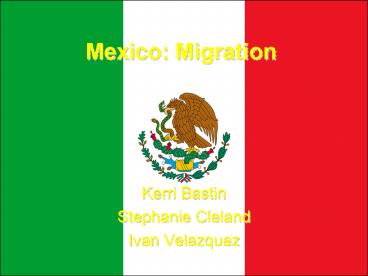Mexico: Migration - PowerPoint PPT Presentation
1 / 24
Title:
Mexico: Migration
Description:
Mexican immigrants living in these areas have brought elements of their own ... Dia de La Bandera (Flag Day) Dia de La Revolucion (Revolution Day) U.S. Reaction ... – PowerPoint PPT presentation
Number of Views:231
Avg rating:3.0/5.0
Title: Mexico: Migration
1
Mexico Migration
- Kerri Bastin
- Stephanie Cleland
- Ivan Velazquez
2
Why do they migrate?
3
Mexican Unemployment Rate 3.3, but 25
Underemployed
Mexican Per Capita Income In Mexico 6,230 In
U.S. 13,003
4
U.S. Unemployment Rate 6
U.S. Per Capita Income 37,610
5
Most Mexican citizens entering the U.S. do so to
send home remittances to their families.
Approximately 40 of Mexicos citizens live below
the poverty line.
Remittances have been steadily rising over the
years, reaching 16 billion in 2004, the largest
income source for Mexico followed by petroleum
and tourism.
6
Who Migrates?
7
Changes have been occurring in the migration
patterns of Mexico over the last several
decades. Historically, males were the ones to
come to the U.S. Today, nearly as many women as
men migrate to the U.S., in some areas more women
migrate
8
(No Transcript)
9
Historically, immigrants coming from Mexico
usually came from Jalisco and Michoacán . Today,
people migrate from areas deeper in Mexico and
more metropolitan, such as Oaxaca and Mexico
City.
10
Legend Historic Regions of Migration New Regions
of Migration
11
Where are they migrating?
12
Approximately 10 of Mexicos population has
migrated to the U.S, or roughly 9.1 million
people. The rate of migration to the U.S. from
Mexico is approximately 500,000 per year, and has
been steadily increasing the U.S.s Mexican
population. The top five states in the U.S. that
receive Mexican immigrants are California,
Texas, Illinois, Arizona and Georgia.
13
(No Transcript)
14
(No Transcript)
15
How are they migrating?
16
Legal Immigration
- 20 of total legal foreign-born population in
the U.S. is from Mexico - or
- 9.8 million people from Mexico
17
Illegal Immigration
- 53 of total illegal foreign-born population in
the U.S. is from Mexico - or
- 5.3 million people from Mexico
18
Cultural Impact
19
Each of the states that Mexicans have migrated to
the most have seen a change in the local
cultures. Mexican immigrants living in these
areas have brought elements of their own culture
and fused it with the local flavor that already
exists. This has created certain stereotypes of
Mexican infused culture to be created in these
areas.
- California Graffiti in murals from the new
generation of Mexicans and lowriders have
contributed to the formation of the stereotype of
Cholos, and Americanized gangster identity. - Texas The popular Tejano music style was
created here, using an influence of accordions.
The most famous artist of this genre in the U.S.
was Selena. Texas has also been the birthplace of
the Vaqueros (cowboys) and Banditos (Bandits)
stereotypes.
20
- Illinois Duranguense Music and Mexican Rap,
styles not popular in Mexico have appeared in
Illinois and gained fame in these areas. The
style was designed to appeal to the U.S. Chicago
has also been the birthplace of the stereotype of
the typical Carnicerias worker. - Arizona The main spring board to other
states, Arizona is home to the most diverse
Mexican population, containing individuals of all
of the previously mentioned stereotypes. Arizona
and California together also produced the
standard field worker stereotype.
21
Festivals
Many traditional Mexican holidays and festivals
have migrated to the U.S. with immigrants. Today,
many states in the U.S. have annual festivals
that originated in Mexico.
5 De Mayo Dia de Los Muertos (Day of the Dead)
Dia de La Bandera (Flag Day) Dia de La
Revolucion (Revolution Day)
22
U.S. Reaction
23
Guest Worker Programs Past and Present
- Bracero Program. This program ran from
1942-1964 and was put in place to help pick up
the slack of U.S. citizens fighting in WWII
overseas. It was run by independent farmers
called the Farm Bureau who did not uphold the
standards of safe work and decent pay. The
program with held 10 of workers pay in savings
accounts that they were to receive upon return to
Mexico. Most have never seen that money. - Guest Worker Program. President Bush proposed a
guest worker program that will allow 400,000
500,000 of Mexicos undocumented workers living
in the U.S. temporary status to work in jobs U.S.
citizens wont take, and will allow them to apply
for a green card in the process. This program is
still in the planning phase.
24
Initiatives
- Proposition 187. In 1994 California passed
Prop187, a law that would allow medical services,
welfare and education only to people who could
prove they were legally in the country, thereby
halting these services to undocumented workers.
Portions of Prop 187 were labeled
unconstitutional in 1998, and were not allowed
to be enacted. - Proposition 200. Prop 200, also known as Protect
Arizona Now (PAN) was passed in the 2004
elections in Arizona. The bill, similar to Prop
187 in California would require people to show
legal residency for some government services and
proof of citizenship to vote. Currently, the
initiative is being opposed in court.























![❤[READ]❤ Storming the Wall: Climate Change, Migration, and Homeland Security (City PowerPoint PPT Presentation](https://s3.amazonaws.com/images.powershow.com/10050418.th0.jpg?_=202406071111)







